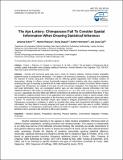Files in this item
The ape lottery : chimpanzees fail to consider spatial information when drawing statistical inferences
Item metadata
| dc.contributor.author | Eckert, Johanna | |
| dc.contributor.author | Rakoczy, Hannes | |
| dc.contributor.author | Duguid, Shona | |
| dc.contributor.author | Hermann, Esther | |
| dc.contributor.author | Call, Josep | |
| dc.date.accessioned | 2021-08-09T11:30:09Z | |
| dc.date.available | 2021-08-09T11:30:09Z | |
| dc.date.issued | 2021-08-01 | |
| dc.identifier | 270617543 | |
| dc.identifier | 7b9a3579-fb69-4fad-bb11-d3e845ee4574 | |
| dc.identifier.citation | Eckert , J , Rakoczy , H , Duguid , S , Hermann , E & Call , J 2021 , ' The ape lottery : chimpanzees fail to consider spatial information when drawing statistical inferences ' , Animal Behavior and Cognition , vol. 8 , no. 3 , pp. 305-324 . https://doi.org/10.26451/abc.08.03.01.2021 | en |
| dc.identifier.issn | 2372-5052 | |
| dc.identifier.other | ORCID: /0000-0002-8597-8336/work/98488038 | |
| dc.identifier.other | ORCID: /0000-0003-4844-0673/work/98488263 | |
| dc.identifier.uri | https://hdl.handle.net/10023/23742 | |
| dc.description | Funding: this work was supported by a research grant of the German Science Foundation DFG (grant # RA 2155/3-1) to Hannes Rakoczy and Josep Call. We acknowledge additional support by the Leibniz Association through funding for the Leibniz ScienceCampus Primate Cognition. | en |
| dc.description.abstract | Humans and nonhuman great apes share a sense for intuitive statistics, making intuitive probability judgments based on proportional information. This ability is of tremendous importance, in particular for predicting the outcome of events using prior information and for inferring general regularities from limited numbers of observations. Already in infancy, humans functionally integrate intuitive statistics with other cognitive domains, rendering this type of reasoning a powerful tool to make rational decisions in a variety of contexts. Recent research suggests that chimpanzees are capable of one type of such cross-domain integration: The integration of statistical and social information. Here, we investigated whether apes can also integrate physical information into their statistical inferences. We tested 14 sanctuary-living chimpanzees in a new task setup consisting of two “gumball machine”-apparatuses that were filled with different combinations of preferred and non-preferred food items. In four test conditions, subjects decided which of two apparatuses they wanted to operate to receive a random sample, while we varied both the proportional composition of the food items as well as their spatial configuration above and below a barrier. To receive the more favorable sample, apes needed to integrate proportional and spatial information. Chimpanzees succeeded in conditions in which we provided them either with proportional information or spatial information, but they failed to correctly integrate both types of information when they were in conflict. Whether these limitations in chimpanzees' performance reflect true limits of cognitive competence or merely performance limitations due to accessory task demands is still an open question. | |
| dc.format.extent | 626685 | |
| dc.language.iso | eng | |
| dc.relation.ispartof | Animal Behavior and Cognition | en |
| dc.subject | Intuitive statistics | en |
| dc.subject | Probabilistic reasoning | en |
| dc.subject | Physical cognition | en |
| dc.subject | Cross-domain integration | en |
| dc.subject | Primates | en |
| dc.subject | Great apes | en |
| dc.subject | QL Zoology | en |
| dc.subject | DAS | en |
| dc.subject.lcc | QL | en |
| dc.title | The ape lottery : chimpanzees fail to consider spatial information when drawing statistical inferences | en |
| dc.type | Journal article | en |
| dc.contributor.institution | University of St Andrews. School of Psychology and Neuroscience | en |
| dc.contributor.institution | University of St Andrews. Centre for Social Learning & Cognitive Evolution | en |
| dc.identifier.doi | 10.26451/abc.08.03.01.2021 | |
| dc.description.status | Peer reviewed | en |
This item appears in the following Collection(s)
Items in the St Andrews Research Repository are protected by copyright, with all rights reserved, unless otherwise indicated.

